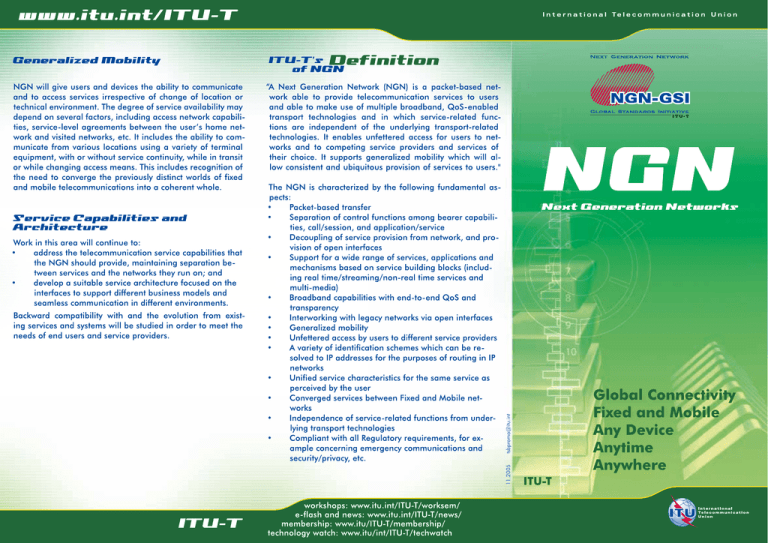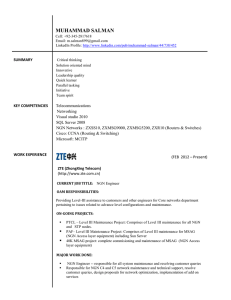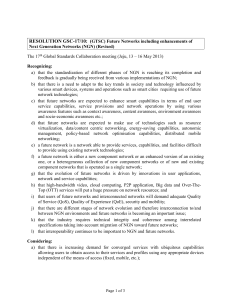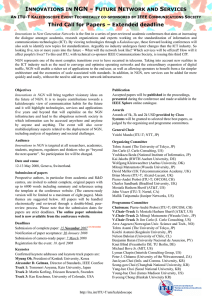Document 12921988
advertisement

www.itu.int/ITU-T Why NGN? The NGN concept takes into consideration new realities in the telecommunication industry characterized by factors such as the need to converge and optimise the operating networks and the extraordinary expansion of digital traffic (i.e., increasing demand for new multimedia services, increasing demand for mobility, etc.). ITU-T's NGN Work ITU-T’s work on NGN can be traced back many years. The current phase started in 2003 when a Joint Rapporteur Group bringing together experts from across all Questions of Study Group 13 was formed. The main subjects studied by the Joint Rapporteur Group on NGN (JRG-NGN) were: NGN requirements, the general reference model, functional requirements and architecture of the NGN, and evolution to NGN. The JRG-NGN produced two fundamental Recommendations, viz. Y.2001, General overview of NGN and Y.2011, General principles and general reference model for next generation networks. In order to continue and accelerate NGN activities initiated by the JRG-NGN, ITU-T established a Focus Group on NGN (FGNGN) in May 2004. Focus groups provide an effective and rapid response mechanism for progressing the work of ITU-T. The FGNGN addressed the urgent need for an initial suite of global standards for NGN. In addition, ITU-T established (September 2004) the NGN Management Focus Group (NGNMFG) to create a roadmap of specifications on NGN management related to fault, configuration, accounting, performance and security management (FCAPS) interfaces. NGN Global Standards Initiative (NGN-GSI) QoS (Quality of Service) The results of the FGNGN (Release 1) provide the building blocks on which the world’s systems vendors and service providers can start to make the shift to NGN. Since the creation of FGNGN there has been an intensive schedule of meetings, about every two months, but more importantly there has been growing momentum in the work, and growth in participation and the number of contributions. Now this work will be carried forward by ITU-T’s NGN-Global Standards Initiative (NGN-GSI), which encompasses all NGN work across ITU-T study groups. For more information: tsbngngsi@itu.int. The basic criterion for QoS evolution is “subjective user satisfaction”, e.g. speed, accuracy, reliability, and security. This involves identification of parameters that can be directly observed and measured at the point at which the service is accessed by users and network providers. Flexibility within the global end-to-end NGN architecture is essential to allow for each recognized operating agency’s different regulatory environment, service offerings, geographic span, and network infrastructure. These factors need to be taken into account when agreeing on parameters for, and levels of, QoS for NGN. NGN Study Topics Interoperability ITU-T activities are related to the establishment of architectures, interface specifications, protocols and implementation guidelines in the form of ITU-T standards (Recommendations) for the realization of NGN. Considering that the NGN will involve a broad series of protocols (including various profiles) at both service and network levels, it is essential to ensure interoperability between different systems and networks. of Networks Evolution to NGN Security The evolution of networks to NGN must allow for the continuation of, and interoperability with, existing networks while in parallel enabling the implementation of new capabilities. Since the realization and deployment of the NGN will be an evolutionary process, and not all networks will start from the same point, it is necessary to describe a variety of approaches. The high capital investment in the PSTN (public switched telephone network) means it must be one of the main work areas for studying evolution to the NGN. The resulting outputs describe possible ways of evolving the PSTN to become an NGN. These outputs provide steps for evolution of transport, management, signalling and control parts of the PSTN to the NGN. Other starting points, notably existing public land mobile networks (PLMNs) and associated transition scenarios, are also under study. Security is as crucial to the NGN as it is in today’s network environment. The very wide scope of this topic, combined with the number of SDOs (standards development organizations) already involved, underlines the strategic importance of this subject. Within the NGN, security issues interrelate with architecture, QoS, network management, mobility, charging and payment. Security studies in NGN are addressing: • a comprehensive security architecture for NGNs • the preparation of NGN operational security policy and guidelines • NGN security protocols and APIs (application programming interface) For more information, see the ITU-T Study Group 13 website at: www.itu.int/ITU-T/studygroups/com13 www.itu.int/ITU-T




